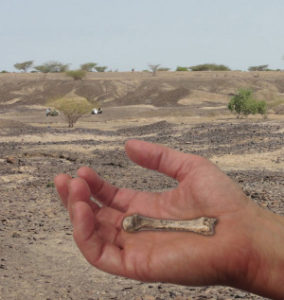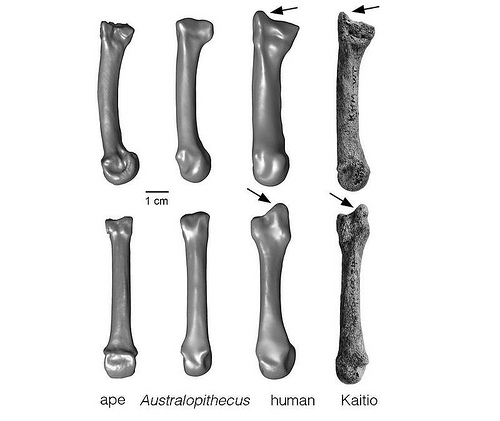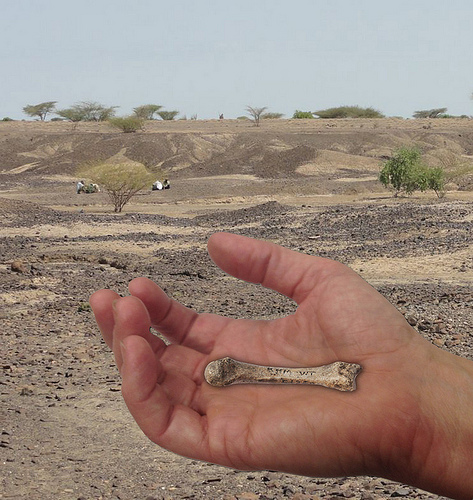
In 2011, a team led by Fredrick Manthi from the West Turkana Paleontology Project of the National Museums of Kenya discovered a well-preserved hominin (early human ancestor) hand bone from the site of Kaitio, located in northern Kenya west of Lake Turkana.
Any hominin fossil find would be considered a rarity when compared to the abundance of finds from other ancient animals. But this fossil was rarer still, for two reasons. First, it was a type of bone (the third metacarpal in the hand) that, along with other distinct anatomical features, allowed humans, in contrast to other primates, the ability to make tools and perform other manipulative functions that are unique to humans. Second, it was dated to about 1.42 million years ago. It constitutes the earliest evidence of a modern human-like hand, indicating that this anatomical feature existed more than half a million years earlier than previously known.
Researchers suspect the bone belonged to the early human species, Homo erectus, a human species that existed between 1.8 million and 143,000 years ago. It is considered the first human species to go global — geographically, Home erectus fossil remains have been found in East Africa, Georgia, India, Sri Lanka, China and Java. The bone was found near sites where the earliest Acheulian tools have appeared. Acheulian tools are ancient, shaped stone tools that include stone hand axes more than 1.6 million years old. They are most often associated with the presence of Homo erectus.
“What makes this bone so distinct,” says Carol Ward, professor of pathology and anatomical sciences at the University of Missouri-Columbia and lead author of the study, “is the presence of a styloid process, or projection of bone, at the end that connects to the wrist. Until now, this styloid process has been found only in us, Neandertals and other archaic humans” whose remains have been dated to much later times.
_________________________________________________________________________________________
The styloid process is a projection of bone. Ward and her team found a styloid process at the end of a hand/wrist bone more than 1.42 million years old, indicating this anatomical feature existed more than half a million years earlier than previously known. By explanation, above, Australopithecus is an early hominin that is generally thought to be ancestral to, and predates, the Homo genus, which contains the earliest species of the human line. Credit: University of Missouri
_________________________________________________________________________________________
Image of the fossil third metacarpal bone shown in its position on the human hand, connecting the wrist with the middle finger. The styloid process allows the hand to lock into the wrist bones, giving humans the ability to apply greater amounts of pressure to the hand. This allows humans to make and use tools. Credit: University of Missouri
_________________________________________________________________________________________
“The styloid process reflects an increased dexterity that allowed early human species to use powerful yet precise grips when manipulating objects. This was something that their predecessors couldn’t do as well due to the lack of this styloid process and its associated anatomy,” Ward said. “With this discovery, we are closing the gap on the evolutionary history of the human hand. This may not be the first appearance of the modern human hand, but we believe that it is close to the origin, given that we do not see this anatomy in any human fossils older than 1.8 million years. Our specialized, dexterous hands have been with us for most of the evolutionary history of our genus, Homo. They are – and have been for almost 1.5 million years – fundamental to our survival.”
The study was published in the Proceedings of the National Academy of Science this week. Members of Ward’s team who helped discover and analyze the bone include: Matthew Tocheri, National Museum of Natural History in the Smithsonian Institution; J. Michael Plavcan, University of Arkansas; Francis Brown, University of Utah; and Fredrick Manthi, National Museums of Kenya.
_________________________
Source: Adapted and edited from a University of Missouri-Columbia press release.
_______________________________________________________________________________________________________________________
Read about the most fascinating discoveries with a premium subscription to Popular Archaeology Magazine. Find out what Popular Archaeology Magazine is all about, including the special Holiday Discount offer. AND MORE:
 On the go? Purchase the current issue of Popular Archaeology Magazine for your Kindle, iPad or iPhone.
On the go? Purchase the current issue of Popular Archaeology Magazine for your Kindle, iPad or iPhone.
And, Popular Archaeology’s annual Discovery edition is a selection of the best stories published in Popular Archaeology Magazine in past issues, with an emphasis on some of the most significant, groundbreaking, or fascinating discoveries in the fields of archaeology and paleoanthropology and related fields. At least some of the articles have been updated or revised specifically for the Discovery edition. We can confidently say that there is no other single issue of an archaeology-related magazine, paper print or online, that contains as much major feature article content as this one. The latest issue, volume 2, has just been released. Go to the Discovery edition page for more information.
Subscription Price: A very affordable $5.75 for those who are not already premium subscribers of Popular Archaeology Magazine (It is FREE for premium subscribers to Popular Archaeology). Premium subscribers should email [email protected] and request the special coupon code. Or, for the e-Book version, it can be purchased for only $3.99 at Amazon.com.







